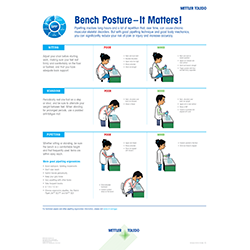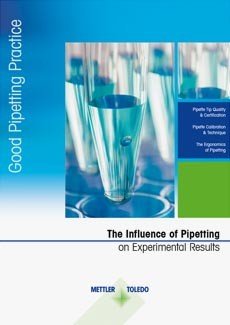Good Pipetting Practice
Good Pipetting Practice
Pipetting Techniques to Boost Your Performance
Improve your data quality with Good Pipetting Practice™ (GPP™) – METTLER TOLEDO’s comprehensive, systematic approach to maximizing pipetting accuracy and repeatability.
GPP covers many topics relevant to life science researchers or anyone using pipettes regularly:
Understand the array of pipettes and liquid handling instruments and options available
Know how to optimize your pipetting workflow
Gain the range of pipetting skills necessary to produce reliable data
Appreciate how pipetting ergonomics can influence data production and your own well being
Recognize the risk associated with out-of-calibration pipettes and the role of routine pipette checks vs. professional pipette service.
How can you profit from the principles of Good Pipetting Practice?
There are several ways for your to access the comprehensive knowledge of the Good Pipetting Practice:
Pipetting Risk Check
Take the GPP Risk Check™ to understand where risks lie in your work and workflow… and how to mitigate them
Pipetting Seminar
Our GPP experts will train you and your team right in your lab. Request a seminar
Pipetting eLearning
If you prefer to learn at your own pace, you can access our GPP seminars in online eLearning sessions
GPP Certificate
If you have done a GPP seminar already, you can request a personalized GPP certificate.
Pipetting Literature
Download pipetting brochures and other pipetting knowledge material around Good Pipetting Practice
Five Pipetting Techniques to Boost your Performance
The following tips and tricks are a short excerpt of one of the many topics covered in our GPP seminars and elearnings.
Here are some very common pipetting technique errors and how to avoid them.
1. Wrong tip immersion depth
The correct tip immersion depth can improve accuracy by up to 5%. The tip should be immersed between 1-2 mm for micro-volume pipettes and up to 3-6 mm for normal-range pipettes, depending on the tip size. If the tip is immersed too far, the volume of gas in the tip is compressed, causing too much liquid to be aspirated.
2. Wrong pipetting angle
The immersion angle of your pipette tip in the sample should be as near to vertical as possible and should not deviate more than 20 degrees from vertical. A more horizontal angle causes too much liquid to be drawn into the tip, resulting in inaccurate aspiration. For example, at an angle of 30 degrees to vertical, up to 0.7% too much liquid can be aspirated.
3. Inconsistent dispensing
Greater accuracy and sample-to-sample reproducibility can be achieved by ensuring that the last remaining droplet dispenses fully and does not adhere to the tip end. For most applications, dispensing with the end of the tip resting against the vessel wall is recommended as it reduces or eliminates the amount of sample remaining in the tip. This technique can increase accuracy by 1% or more.
4. Failure to pre-rinse
Dispensing liquid from a pipette leaves a coating of the liquid on the tip, making the expelled volume slightly less than it should be. Pre-rinsing a new tip at least twice with the liquid about to be used will condition the inside of the tip.
5. Inconsistent pipetting rhythm
Use a consistent pipetting rhythm from sample to sample. Avoid hurrying or rapid operation and get into a rhythm for each step in the pipetting cycle.
These five simple techniques alone can have a big impact on your results, but there are a few more to consider.
As
part of our Good Pipetting Practice™ program, METTLER TOLEDO has
developed a quick Risk Check to help you assess your personal pipetting
risks and learn how to reduce them. You'll get a personalized Risk
Analysis Report that you can view and print online.
GPP is all
about helping you learn to improve your pipetting accuracy and recognize
when your pipettes are not working properly.
Good Pipetting Practice Risk Check
Minimize pipetting workflow-related risks
It will just take a few minutes to assess your pipetting risks and get some useful hints on reducing these risks.
Pipetting Risk Check
Take the GPP Risk Check™ to understand where risks lie in your work and workflow… and how to mitigate them
Pipetting Seminar
Our GPP experts will train you and your team right in your lab. Request a seminar
Pipetting eLearning
If you prefer to learn at your own pace, you can access our GPP seminars in online eLearning sessions
GPP Certificate
If you have done a GPP seminar already, you can request a personalized GPP certificate.
Pipetting Literature
Download pipetting brochures and other pipetting knowledge material around Good Pipetting Practice
GPP Certificate
Did you know that you can request a certificate if you have taken a GPP seminar?
Click the link and follow the instructions to get your own, personalized GPP training certificate.
Pipetting Literature
Access pipetting brochures and other pipetting knowledge material around Good Pipetting Practice.

人体工程学移液海报
起立伸展! 立即免费索取“手、胳膊和肩膀”海报,让移液更符合人体工程学。

Rainin 移液技法

Rainin “工作台前操作姿势 – 至关重要!”
Rainin “工作台前操作姿势 – 至关重要!” 海报提供了关于正确操作姿势的内容,以防止实验室工作人员患慢性肌肉骨骼疾病。

Pipetting Toolbox for Life Sciences
The use of pipettes to transfer liquids is a daily activity in most life science research labs. Therefore the impact on research results is equally substantial. Our Pipetting Toolbox for Life Sciences guides you through pipette & tip selection and calibration, as well as pipetting technique.







